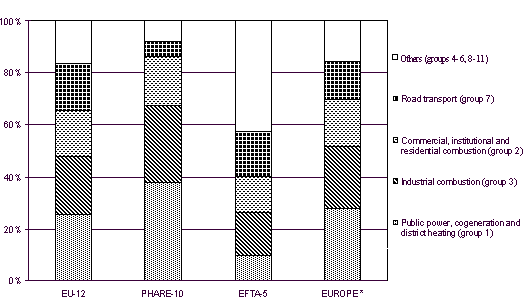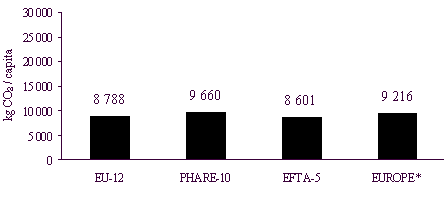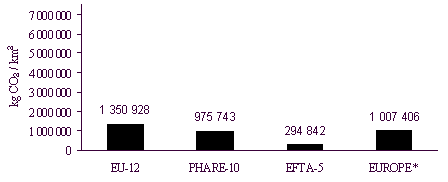6. CARBON DIOXIDE -
CO2
6.1 CO2-emissions by countries
The 1990 annual total CO2-emissions for
EUROPE were estimated to be 4 764 million tonnes. These emissions broken down by EU-12,
EFTA-5 and PHARE-10 countries are shown in figure 6.1. The largest contributor were the
EU-12 countries with 64%, second largest the PHARE-10 countries with 22%; EFTA-5 countries
with 8% and Germany (former East) and Malta contributed 6%.
Figure 6.1: Contribution in % to the EUROPEAN total
CO2-emissions

*) Croatia not yet available
Figure 6.2 shows the relative contribution of
individual countries to the total of 4 765 million tonnes. In 1990 the largest
contributing countries were Germany (former West; 15%), the United Kingdom (12%), Italy
(10%) and France (10%); the smallest contributing countries were Malta (0.05%), Luxembourg
(0.2%) and Slovenia (0.3%). These differences are due to different size of population and
different per capita emissions (see also paragraph 6.3).
Figure 6.2: Contribution in % of each country to the
EUROPEAN total CO2-emissions

*) Croatia not yet available
6.2 CO2-emissions per group
Eighty-five percent of the CO2-emissions
for EUROPE resulted from the groups 1 (public power, cogeneration and district heating),
group 2 (commercial, institutional and residential combustion), group 3 (industrial
combustion) and group 7 (road transport). Group 1 contributed the largest share with 28%
to the total, group 3, group 2 and group 7 (road transport) were the groups with the next
largest contributions of 24%, 18% and 15%. The remaining 16% of the total emissions can be
attributed almost exclusively to emissions of the groups 4 (production processes), 5
(extraction and distribution of fossil fuels), 8 (other mobile sources and machinery), 9
(waste treatment and disposal) and 11 (nature).
The split of the CO2-emissions into
groups for EU-12 and PHARE-10 countries is quite similar compared to the split for EUROPE
with the exception of the relative large contribution of group 1 (public power,
cogeneration and district heating plants) with 38% and a smaller contribution of the group
7 (road transport) with 6% for the PHARE-10 countries. For the EFTA-5 countries group 11
(nature) showed a larger contribution with 25% and groups 1, 2 and 3 with 10%, 14% and 17%
a smaller contribution compared to the split for EUROPE.
The differences of contributions of individual
source groups to the total emissions are larger between countries than these groups (see
also table 6.1). The contribution of group 1 ranges from 65% (Estonia) to 1% (Norway,
Switzerland), of group 2 from 39% (Switzerland) to 2% (Greece), of group 3 from 58%
(Luxembourg) to 2% (Greece) and of group 7 (road transport) from 26% (Austria) to 2%
(Romania).
However it is evident from these differences in the
relative contribution of sourcegroups to a countries total emissions that strategies for
reduction of CO2-emissions need individual solutions as well as common
elements.
Figure 6.3: Contribution in % of source groups to
the EUROPEAN CO2-emissons

*) Croatia not yet available
6.3 CO2-emissions
per capita
For EUROPE the average CO2-emissions per
capita were 9 216 kg/capita. Compared to this number the per capita CO2-emissions
were 5% larger for the PHARE-10 countries with 9 660 kg/capita, 5% smaller for the EU-12
countries with 8 788 kg/capita and 7% smaller for the EFTA-5 countries with 8 601 kg
/capita. This comparison is also shown in figure 6.4 and table 9.
Figure 6.4: CO2-emissions per capita for
EUROPE

*) Croatia not yet available
Again the differences are much larger if individual
countries are compared: the largest CO2-emissions per capita were estimated for
Luxembourg (29 546 kg/capita) and the next largest ones for Estonia (18 891 kg/capita) and
for Germany (former East; 18 244 kg/capita); the smallest per capita emissions for CO2
were calculated for Portugal (4 587 kg/capita), Hungary (5 663 kg/capita) and France (6
641 kg/capita). Figure 6.5 shows the countries ranked according their per capita
emissions. The already mentioned special report for CO2 will analyse these
large differences in the per capita emissions for CO2; the smallest per capita
emissions being a factor of 6 smaller compared to the largest number.
Figure 6.5: CO2-emissions per capita for
individual countries

*) Croatia not yet available
6.4 CO2-emissions per km2
For EUROPE the average CO2-emissions per
km2 were estimated as 1 007 406 kg/km2. Compared to this number the
per km2 CO2-emissions were 34% larger for the EU-12 countries with 1
350 928 kg/km2, 3% smaller for the PHARE-10 countries with 975 743 kg/km2
and 71% smaller for the EFTA-5 countries with 294 842 kg/km2. This comparison
is also shown in figure 6.6 and table 10.
Figure 6.6: CO2-emissions per km2 for
EUROPE

*) Croatia not yet available
Again the differences are much larger if individual
countries are compared; the largest CO2-emissions per km2 were for
Malta (6 987 342 kg/km2) and the next largest ones for Luxembourg (4 348 028
kg/km2), Belgium, Flemish region (3 901 938 kg/km2) and the
Netherlands (3 840 638 kg/km2). The smallest emissions per km2 for
CO2 were for Norway (106 215 kg/km2), Finland (168 737 kg/km2)
and Latvia (283 800 kg/km2). Figure 6.7 shows the countries ranked according
their CO2-emission per km2. The differences in the emissions per km2
between countries are much larger compared to the per capita emissions. The smallest
number being 66 times smaller than the largest number.
Figure 6.7: CO2-emissions per km2 for
individual countries

*) Croatia not yet available
Table 6.1: Carbon dioxide
emissions per country and group








Document Actions
Share with others